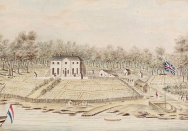The 68th United Nations General Assembly has declared 2016 the International Year of Pulses (IYP), recognising the vital role they play in nutrition across the globe, and other merits. They’re also a rich part of Australia’s food heritage.
Pulses include the myriad varieties of peas and beans that are grown and harvested for use as a dried product, which we generally refer to as lentils or dried legumes. Not only are they highly nutritious for humans and animals to eat they also, unlike many other food crops, enrich the soil they are grown in rather than deplete it.

International Year of Pulses (IYP) 2016 official logo. Food and agriculture organization of the United Nations. http://www.fao.org/pulses-2016/en/
Pease please me
Lentils, chickpeas and beans are a staple in many cultures, as key ingredients in stews, hotpots, soups and ‘dhal’ type dishes – and how many of us reach for a can of baked beans when we need something quick and sustaining, for breakfast or supper? They contain valuable carbohydrate and protein, and very low GI. They provide bulk and substance to a meal, and act as a ‘carrier’ for meat, which in many places is an extravagance. French cassoulet is a good example, or South American ‘pork and beans’ and good old British comfort food, pea and ham soup.
First Fleet fare
Pease porrige hot, pease porrige cold,
pease porrige in the pot, nine days old.
Some like it hot, some like it cold,
pease porridge in the pot, nine days old.
Here in Australia, pulses were a vital component of our early colonists’ diet, brought from England as part the First Fleet rations. At the standard ration colonists were issued 3 pints of ‘pease’ per week, which equates to about one cup, uncooked, per day. Commonly known then as ‘pease’ (see the rationale for this below), callavances or carravances, dried peas were a staple foodstuff that stored and traveled well, were highly nutritious, filling, and economical. Following longstanding British naval traditions, they were cooked into a ‘pease porridge’ giving rise to the Mother Goose nursery rhyme verse which was popularised in the early 1700s.
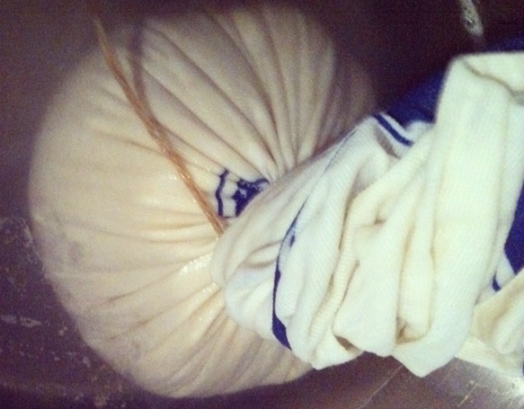
Pease pudding in the pot – a few hours old. Photo © Jacqui Newling
Boil-in-the-bag technology
This gruel-type dish is still with us in the form of ‘mushy peas’ – most usually served atop a meat pie or beneath for a pie floater. It is typically made with the ‘marrowfat’ variety of pea, which was one of the plants brought to New South Wales on the First Fleet for cultivation. Pease were also used to make a more robust ‘pease pudding’, boiled in a calico pudding cloth. Usually made with what we would now identify as yellow split peas, from the chickpea variety, the pease are soaked overnight before being wrapped in a cloth – fairly loosely, to allow for them to swell as they cook. They are boiled for two hours or more, until quite soft. The cloth is then transferred into a colander and untied, and the pease crushed ‘to a paste’ with the back of a wooden spoon. A lump of butter and some salt and pepper are mixed into the mass, then the cloth is bound again, quite tightly this time, and the pudding cooked for another half hour. A richer pudding can be made with the addition of eggs as well as butter.
It was quite an art, to produce a pudding of the right consistency, as Eliza Acton advises:
‘They [the pease] must have room to swell or they will be hard; but if too much be given they will be water, and it will be difficult to convert them into a pudding at all.’
Bundles of joy
This style of cookery was peculiarly British (and by default, her colonies’) as we’ve discussed in the past – Puddings, puddings, all year round. Boiled puddings were a practical and inexpensive way of containing food, especially when cooking happened communally – you could have many puddings bobbing around in a cauldron at once. If meat was being boiled at the same time (corned beef style) the puddings would take on the meaty flavour and from the broth. The traditional practice of Christmas puddings being cooked in the laundry copper is reminiscent of this practice.
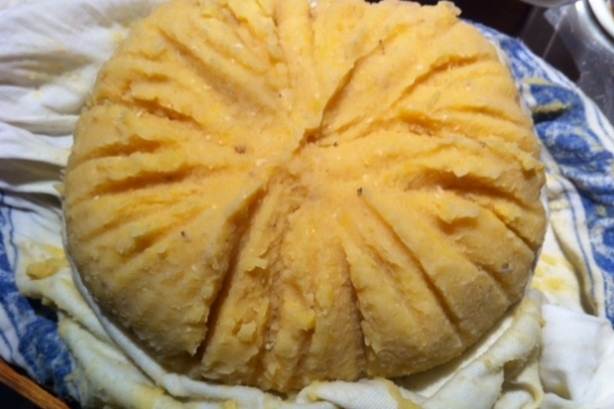
Pease pudding ready to turn onto a plate. Photo © Jacqui Newling
The rhyme was soon revised to pease pudding hot, pease pudding cold, and as it indicates, they were were enjoyed both hot and cold. Served hot the mealy mush was not unlike mashed potatoes, but with a distinctive fresh leguminous taste, fresh mung bean-like. As the pudding cooled the pease would set (you may find pea soup does the same once stored in the fridge, depending how thick you’ve made it). The pudding could be cut into slices like a cake and eaten cold, and quite handy as a ‘grab-and-go’ breakfast or snack.
A new kid on the block
While it seems rather arcane, pease pudding remains a nostalgia food in the England. My father (born 1927) had fond childhood memories of his mother cooking it for him. These days we still eat ‘pease’ in other ways, but pease puddings have dropped away from our repertoire, largely due to the increasing dominance of the potato. Given that a pease pudding needed many hours to prepare to produce a mealy mash, potatoes could do the same job in a fraction of the time, and a tradition was lost.
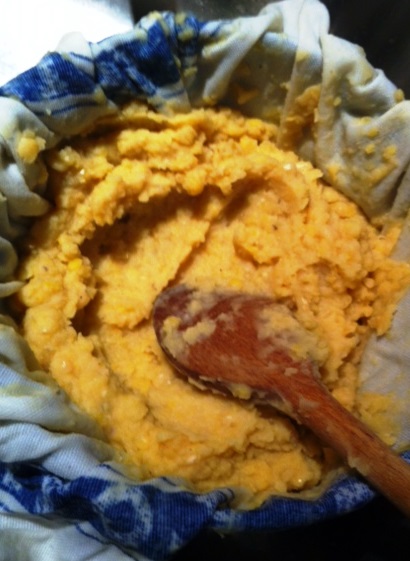
Working the butter into the pudding. Photo © Jacqui Newling
pease ain’t peas
I am constantly challenged by editors and computer-generated spell-check when I write about pease. The debate as to which is correct terminology has evidently been a point of discussion for some time. Ponsonby A. Lyons, in Notes and queries (1870) cites Johnson’s dictionary:
In the plural we write pease for two or more individual seeds, but pease for an indefinite number in quantity or bulk. Pease-soup is soup made from pease; it is to be considered as differing from pea-soup, I e soup made from pease, as green-pea soup.
Source: ‘Pease and peas’. Notes and Queries, 4th S. V1. August 13, 1870
Pease pudding
Ingredients
- 2 cups yellow split peas
- 2 tablespoons butter
- salt and white pepper
Note
Pease are dried split peas, either green or yellow, though I'm told yellow is the one for traditional pease pudding. It was the standard accompaniment to boiled pork, these days we do it the other way around, boiling pork in with the peas for pea and ham soup. Leftovers could be served cold, in slices, or fried in butter or bacon fat for a rib-sticking breakfast or supper.
You'll need a 40cm square pudding cloth or clean woven tea towel to make this pudding.
Directions
| Bring a large pot of water to the boil. Rinse the cloth in water, wring out and lie it across a shallow mixing bowl. Place peas in the centre, then bring the corners and sides of the cloth up around the peas, to tie up securely with kitchen string or a thick rubber band, but leaving plenty of space for the peas to swell. Do not be tempted to add salt or seasoning at this stage, the peas will toughen if salt is added, but you can add flavour to the water by adding aromats - a whole onion, stalks of celery and a carrot or two, and meaty stock bones if desired. | |
| Place the pudding into the boiling water, partially cover the pot, and cook on a steady heat for two and a half hours, topping up with boiling water as needed. Using tongs, remove the pudding from the water and place in a mixing bowl. Untie the cloth, and mash the contents with the back of a large wooden spoon, or pass through a ricer or fine colander. The peas should have broken down and be fairly mushy, mashing will make them pasty, thick and fairly smooth. Add butter, salt and pepper and mix through the mash, retie the cloth, more closely this time, and return to the pot to boil for another hour. To serve, turn the pudding out into a serving dish, and serve out with a spoon, or if really dense, in slices like a pie. | |
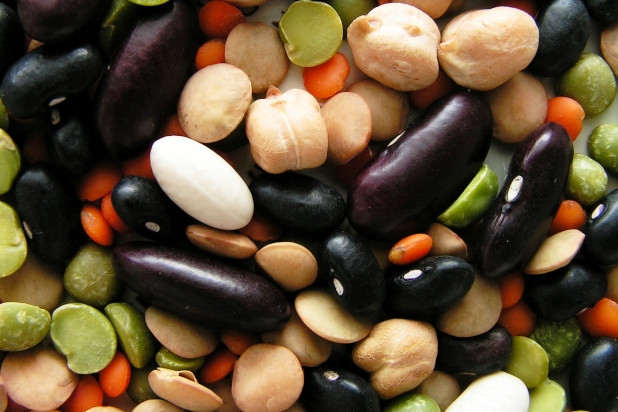
 Print recipe
Print recipe
